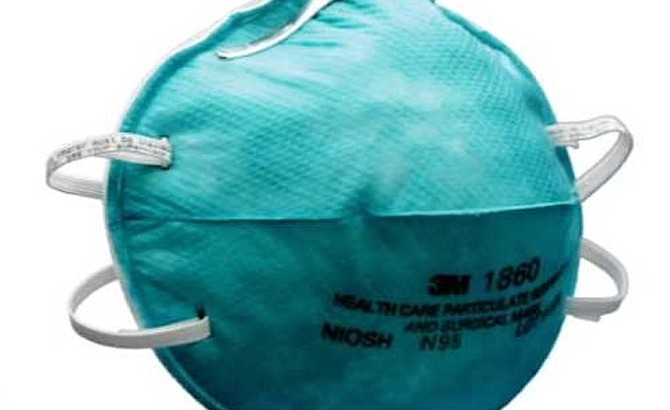 Facebook
Facebook
 X
X
 Instagram
Instagram
 TikTok
TikTok
 Youtube
Youtube

The local toll of COVID-19 keeps rising. Over six hundred confirmed cases as of Monday, March 30. An unknown number of infected people out and about. Ten million dollars per month and climbing in costs to the county. And as one nurse warns about his workplace: two boxes of face shields left.

It's not just hospital workers needing more protective gear. Frontline workers in the field, at prisons, out working with parolees, including clients who are homeless, have weakened immune systems; all face the unknown every day.
"Everything is on back order, and we need supplies now," Augustin Rucobo, a public health nurse in tuberculosis control and refugee health, told county supervisors in a zoom conference call last week. His department "already works with a deadly infectious disease," and patients include seniors and those without housing or established health care.
Rucobo and other union healthcare workers spoke remotely – or tried. It was a new experience for the county, as one glitch after another left callers behind a wall of silence, amid echoes, delays in the live feed, and directions by staff to "unmute your device."

Field staff, prison staff, and others are running out of masks, gloves, gowns and protective eyewear, Rucobo said. "If we're going to expand field services for the county, we need supplies."
Alicia Shirley, a supervisor in the probation department, said their clients have challenges "that amplify the risks during the coronavirus pandemic," such as addiction, illness, hygiene and weakened immune systems. "The work probation staff do cannot easily be done from six feet away in all cases."
All front-line workers, including social workers, mental health professionals, and probation staff need protective gear, Shirley said. "All workers who conduct house visits and interact in close quarters with parolees, clients, probationers, and patients need professionally fitted N95 masks."
The county declared a public health state of emergency on February 14. "But even then we had no idea the severity of what we would be facing," said county chief administrative officer, Helen Robbins-Myer.
With too few supplies, personal protective gear is being given out where the county deems it most important. All first responders and hospital personnel who are in contact with symptomatic members of the public are given priority, she said. "That is critical."
The second group given priority to receive face shields, masks, gloves and garb are those dealing with people that may not have positive COVID symptoms but have been in direct contact with someone that does.
"There are many other frontline folks who are doing heroic work every single day," and the county wants to get supplies to them. "But there are shortages," she said. "So we just cannot hand out personal protective equipment to folks that may come into a family and may have somebody that has a fear that they are going to get COVID 19."
However, a dearth of tests still hinders efforts to track the spread, causing more uncertainty for workers.
At the county's emergency operations center, "each of our staff has their temperature taken every morning as they enter," said Don Steuer, the assistant chief administrative officer and COVID19 incident commander.
The emergency operations system is at level 1, the highest level, he said, "bringing the emergency operations center, medical operations center, city departments, and community partners together through teleworking."
All requests for supplies go through the web emergency operations center, said Dr. Wilma Wooten, San Diego county public health officer. "We have many reports of doctors and nurses that don't have the supplies they need," she acknowledged. "We were low and are low on face shields, gowns, and goggles," she said, but they were expecting supplies from the strategic national stockpile that day.
Supervisor Desmond asked for numbers of people who've recovered to be included in the tally of cases. "If people are coming off that list, that data should be tracked and given to the public as well. We've been collecting this since February 14 – 230 people testing positive," he said, but 230 has soared to over 600 a week later.
"Our number of cases continues to increase at a rapid rate," Robbins-Myer said. "We are still climbing that curve."
And there is no way to track people sick at home, Wooten said. Patients who are hospitalized require two negative tests 24 hours apart before they can be discharged, and that much is captured "because we are capturing all positive and negative tests so that we can understand where our local testing capacity is."
Wooten said the county should have more San Diego-specific data in coming weeks. "Once we get up to full capacity with testing we will know how many tests and how many positives," she said.
Only about 20 percent of those who contract the virus develop symptoms requiring hospitalization. "We've been telling people with mild to moderate symptoms to stay home." But not everyone is on board yet, she said.
"We know there are a lot of individuals who are out there who are infected."


The local toll of COVID-19 keeps rising. Over six hundred confirmed cases as of Monday, March 30. An unknown number of infected people out and about. Ten million dollars per month and climbing in costs to the county. And as one nurse warns about his workplace: two boxes of face shields left.

It's not just hospital workers needing more protective gear. Frontline workers in the field, at prisons, out working with parolees, including clients who are homeless, have weakened immune systems; all face the unknown every day.
"Everything is on back order, and we need supplies now," Augustin Rucobo, a public health nurse in tuberculosis control and refugee health, told county supervisors in a zoom conference call last week. His department "already works with a deadly infectious disease," and patients include seniors and those without housing or established health care.
Rucobo and other union healthcare workers spoke remotely – or tried. It was a new experience for the county, as one glitch after another left callers behind a wall of silence, amid echoes, delays in the live feed, and directions by staff to "unmute your device."

Field staff, prison staff, and others are running out of masks, gloves, gowns and protective eyewear, Rucobo said. "If we're going to expand field services for the county, we need supplies."
Alicia Shirley, a supervisor in the probation department, said their clients have challenges "that amplify the risks during the coronavirus pandemic," such as addiction, illness, hygiene and weakened immune systems. "The work probation staff do cannot easily be done from six feet away in all cases."
All front-line workers, including social workers, mental health professionals, and probation staff need protective gear, Shirley said. "All workers who conduct house visits and interact in close quarters with parolees, clients, probationers, and patients need professionally fitted N95 masks."
The county declared a public health state of emergency on February 14. "But even then we had no idea the severity of what we would be facing," said county chief administrative officer, Helen Robbins-Myer.
With too few supplies, personal protective gear is being given out where the county deems it most important. All first responders and hospital personnel who are in contact with symptomatic members of the public are given priority, she said. "That is critical."
The second group given priority to receive face shields, masks, gloves and garb are those dealing with people that may not have positive COVID symptoms but have been in direct contact with someone that does.
"There are many other frontline folks who are doing heroic work every single day," and the county wants to get supplies to them. "But there are shortages," she said. "So we just cannot hand out personal protective equipment to folks that may come into a family and may have somebody that has a fear that they are going to get COVID 19."
However, a dearth of tests still hinders efforts to track the spread, causing more uncertainty for workers.
At the county's emergency operations center, "each of our staff has their temperature taken every morning as they enter," said Don Steuer, the assistant chief administrative officer and COVID19 incident commander.
The emergency operations system is at level 1, the highest level, he said, "bringing the emergency operations center, medical operations center, city departments, and community partners together through teleworking."
All requests for supplies go through the web emergency operations center, said Dr. Wilma Wooten, San Diego county public health officer. "We have many reports of doctors and nurses that don't have the supplies they need," she acknowledged. "We were low and are low on face shields, gowns, and goggles," she said, but they were expecting supplies from the strategic national stockpile that day.
Supervisor Desmond asked for numbers of people who've recovered to be included in the tally of cases. "If people are coming off that list, that data should be tracked and given to the public as well. We've been collecting this since February 14 – 230 people testing positive," he said, but 230 has soared to over 600 a week later.
"Our number of cases continues to increase at a rapid rate," Robbins-Myer said. "We are still climbing that curve."
And there is no way to track people sick at home, Wooten said. Patients who are hospitalized require two negative tests 24 hours apart before they can be discharged, and that much is captured "because we are capturing all positive and negative tests so that we can understand where our local testing capacity is."
Wooten said the county should have more San Diego-specific data in coming weeks. "Once we get up to full capacity with testing we will know how many tests and how many positives," she said.
Only about 20 percent of those who contract the virus develop symptoms requiring hospitalization. "We've been telling people with mild to moderate symptoms to stay home." But not everyone is on board yet, she said.
"We know there are a lot of individuals who are out there who are infected."
Comments